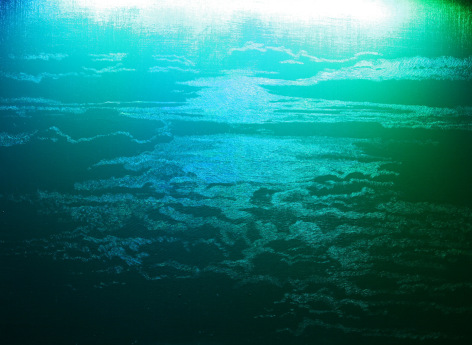In this survey of works on paper and works that utilize paper in different ways, six Chinese artists of different generations offer surprising perspectives on the range of artistic practice in China today and the versatility of the material itself. In the hands of Lu Shengzhong (b. 1952) and his pupil Wu Jian’an (b. 1980), paper is colored and cut until its structural cohesiveness is virtually denied. Lu Shengzhong, the pioneer in the scholarly investigation of this traditional form of Chinese folk art, developed his own intricate expressive style, using the left-over scraps from the paper-cutting process as essential parts of the overall design. After Effects of Tiananmen VII, 2000 was his response to the tragic events of 1999, a rare contemporary reference in an oeuvre that is normally more concerned with timeless themes as in the hand-made The Book of Humanity, Volume III, 2002-2004.
While Lu Shengzhong and his team of folk art paper- cutters were working on his series of books, Wu Jian’an was responding to the SARS epidemic. Fearful and depressed, he used the techniques he had learned from his master in a highly idiosyncratic way. Speaking of his wild inventions, he has said that “I systematically dissected my mind, as if to reveal everything inside and hang up the contents to expose them in the sun.” Tibetan thangkas and Salvador Dali at his most delirious meet in the paper-cuts of Wu Jian’an.
Hong Hao (b.1965) is also obsessed with paper although he values it for its traditional role as a purveyor of printed information. Having started as a print-maker with the celebrated Selected Scriptures, Hong Hao turned to the theme of the book in a virtuoso series of three-dimensional works. His bibliophilic variations range from catalogs of non-existent biennales – The Manuscript for Oahgnoh Biennale A and B, 2003-2004 – to the perfectly void pages of Mexico-Huun-Amate, 2004 of which he has said that “it is a book without content. The book is also completely devoid of text. Instead, there is only paper onto which I’ve used a brush to paint fibers to give the appearance of handmade paper.”
Unlike many of his contemporaries Wang Tiande (b. 1960) did not turn to oil painting at the beginning of his career but decided that his preference lay in “redefining ink painting and calligraphy, the most value-laden of China’s art forms.” While Ai Weiwei smashed and painted over Neolithic and Han Dynasty vessels, Wang Tiande made ordinary vessels and wine bottles more precious by covering them in integuments of Chinese paper suffused with ink wash.
These three-dimensional works contrast with the more conventional format of the drawings / ink paintings of Qiu Zhijie (b. 1969) and Guo Hongwei (b. 1982), the youngest artists in the group. Qiu Zhijie has established his reputation as one of the foremost experimental artists in China, a pioneer in the field of video, installation and every possible permutation but he is also a gifted practitioner in the most traditional Chinese art forms, ink painting and calligraphy. As an offshoot of the ongoing Nanjing Yangtze River Bridge project, Qiu Zhijie has plunged into a rapidly growing series of works on paper inspired by Chinese legends and popular sayings. Deeply rooted in Chinese tradition but resolutely contemporary in the free-wheeling nature of the imagery Qiu Zhijie has shown that he is equally comfortable painting on the monumental scale of the recent wall painting at Chambers Fine Art or on the more conventional scale of the recent series of works on paper. A selection of these is being shown for the first time after a delay at US Customs prevented them from arriving in time for the March 12 opening of his one person show.
In contrast Guo Hongwei does not dwell in the ancient past and has no particular interest in the rich cultural history of his native land. On the other hand, he is not totally immersed in the most up-to-date aspects of today’s popular culture as are many of his contemporaries. Slightly removed from the immediate present, Guo Hongwei looks back in time to his own childhood and adolescence for the subject-matter of his poetic and humorous watercolors. Seemingly effortless, these rapidly executed watercolors are notable for the control he is able to maintain over his fluid medium. From pools of thinly diluted watercolor that could very easily become abstract forms, human figures engaged in mundane or private activities slowly emerge. Among young Chinese artists of his generation, Guo Hongwei is noteworthy for the highly personal nature of his imagery and his extraordinary mastery of the difficult water-color medium.










